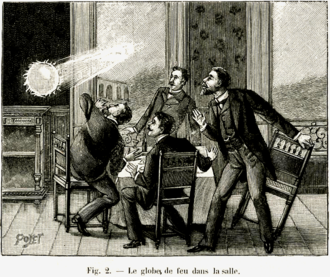
Back برق كروي Arabic Kamūlėnis žaibs BAT-SMG Клубкаватая маланка BE-X-OLD Кълбовидна мълния Bulgarian Llamp globular Catalan Kulový blesk Czech Kuglelyn Danish Kugelblitz German Globa fulmo Esperanto Rayo globular Spanish

Ball lightning is a rare and unexplained phenomenon described as luminescent, spherical objects that vary from pea-sized to several meters in diameter. Though usually associated with thunderstorms,[1] the observed phenomenon is reported to last considerably longer than the split-second flash of a lightning bolt, and is a phenomenon distinct from St. Elmo's fire.
Some 19th-century reports[2][3] describe balls that eventually explode and leave behind an odor of sulfur. Descriptions of ball lightning appear in a variety of accounts over the centuries and have received attention from scientists.[4] An optical spectrum of what appears to have been a ball lightning event was published in January 2014 and included a video at high frame rate.[5][6] Laboratory experiments have produced effects that are visually similar to reports of ball lightning, but how these relate to the supposed phenomenon remains unclear.[7][8]
Scientists have proposed a number of hypotheses to explain reports of ball lightning over the centuries, but scientific data on ball lightning remain scarce. The presumption of its existence has depended on reported public sightings, which have produced inconsistent findings. Owing to the lack of reproducible data, the existence of ball lightning as a distinct physical phenomenon remains unproven.[9]
- ^ Nunez, Christina (6 March 2019). "Ball lightning: weird, mysterious, perplexing, and deadly". www.nationalgeographic.com. Archived from the original on 17 February 2021. Retrieved 2 July 2022.
- ^ Cite error: The named reference
Rowe1905was invoked but never defined (see the help page). - ^ Cite error: The named reference
Day1813was invoked but never defined (see the help page). - ^ Trimarchi, Maria (7 July 2008). "Does ball lightning really exist?". HowStuffWorks.com. Retrieved 25 June 2019.
- ^ Cen, Jianyong; Yuan, Ping; Xue, Simin (17 January 2014). "Observation of the Optical and Spectral Characteristics of Ball Lightning". Physical Review Letters. 112 (3): 035001. Bibcode:2014PhRvL.112c5001C. doi:10.1103/PhysRevLett.112.035001. PMID 24484145.
- ^ Slezak, Michael (16 January 2014). "Natural ball lightning probed for the first time". New Scientist. 221 (2953): 17. Bibcode:2014NewSc.221...17S. doi:10.1016/S0262-4079(14)60173-1. Retrieved 22 January 2014.
- ^ Letzter, Rafi (6 March 2018). "The 'Skyrmion' May Have Solved the Mystery of Ball Lightning". Live Science. Retrieved 20 January 2019.
- ^ Manykin, E. A.; Zelener, B. B.; Zelener, B. V. (2010). "Thermodynamic and kinetic properties of nonideal Rydberg matter". Soviet Journal of Experimental and Theoretical Physics Letters. 92 (9): 630. Bibcode:2010JETPL..92..630M. doi:10.1134/S0021364010210125. S2CID 121748296.
- ^ Anna Salleh (20 March 2008). "Ball lightning bamboozles physicist". 35.2772;149.1292: Abc.net.au. Retrieved 21 January 2014.
{{cite web}}: CS1 maint: location (link)
© MMXXIII Rich X Search. We shall prevail. All rights reserved. Rich X Search